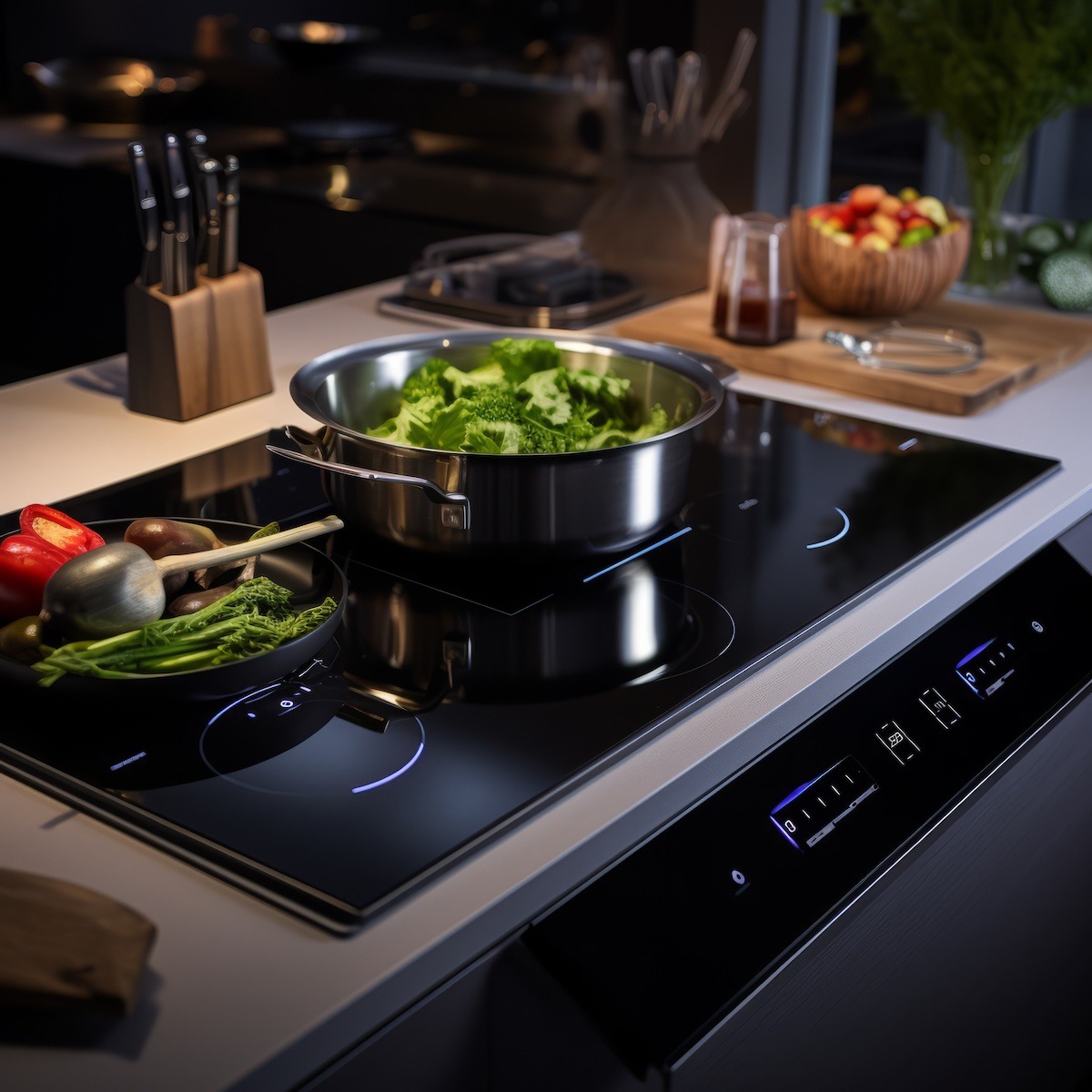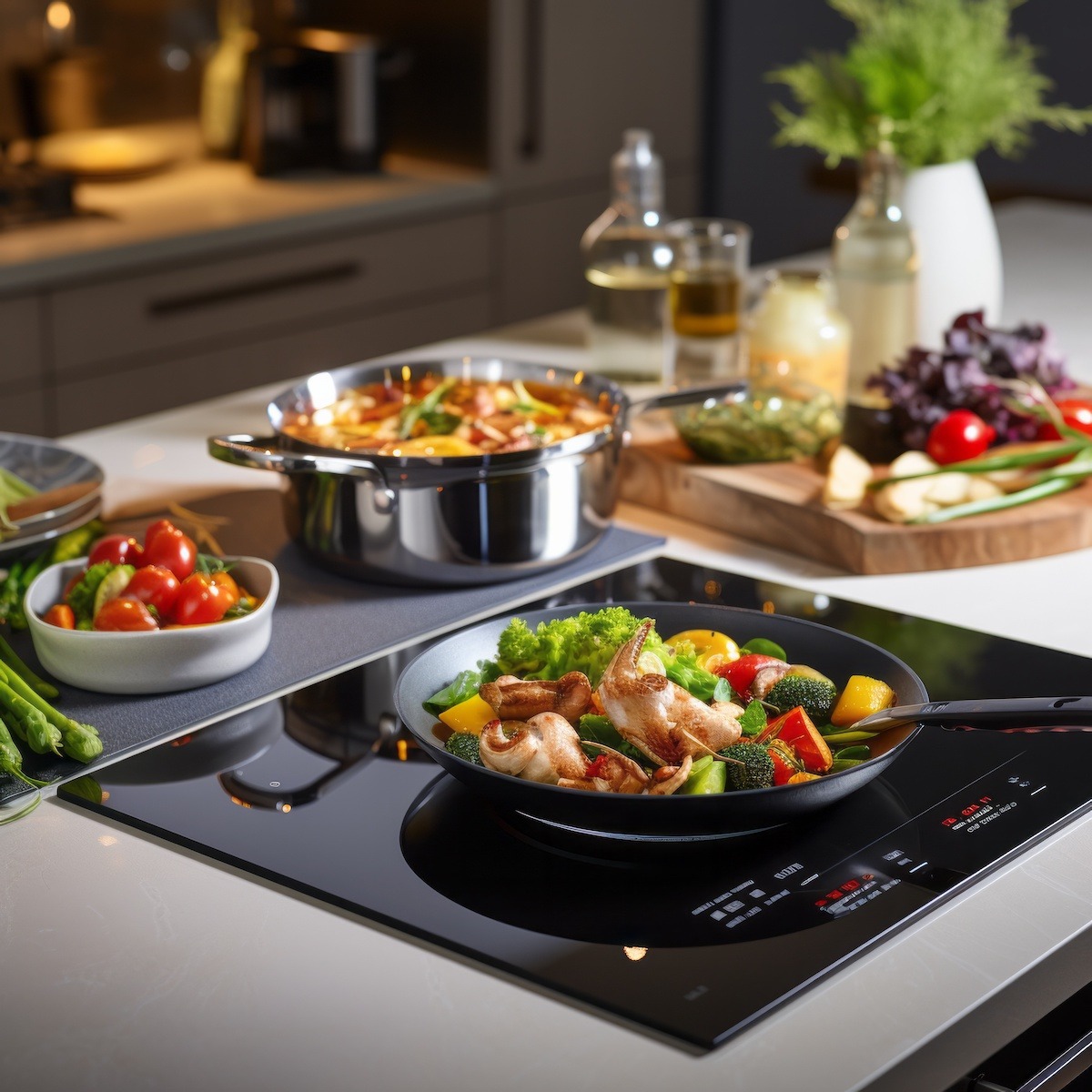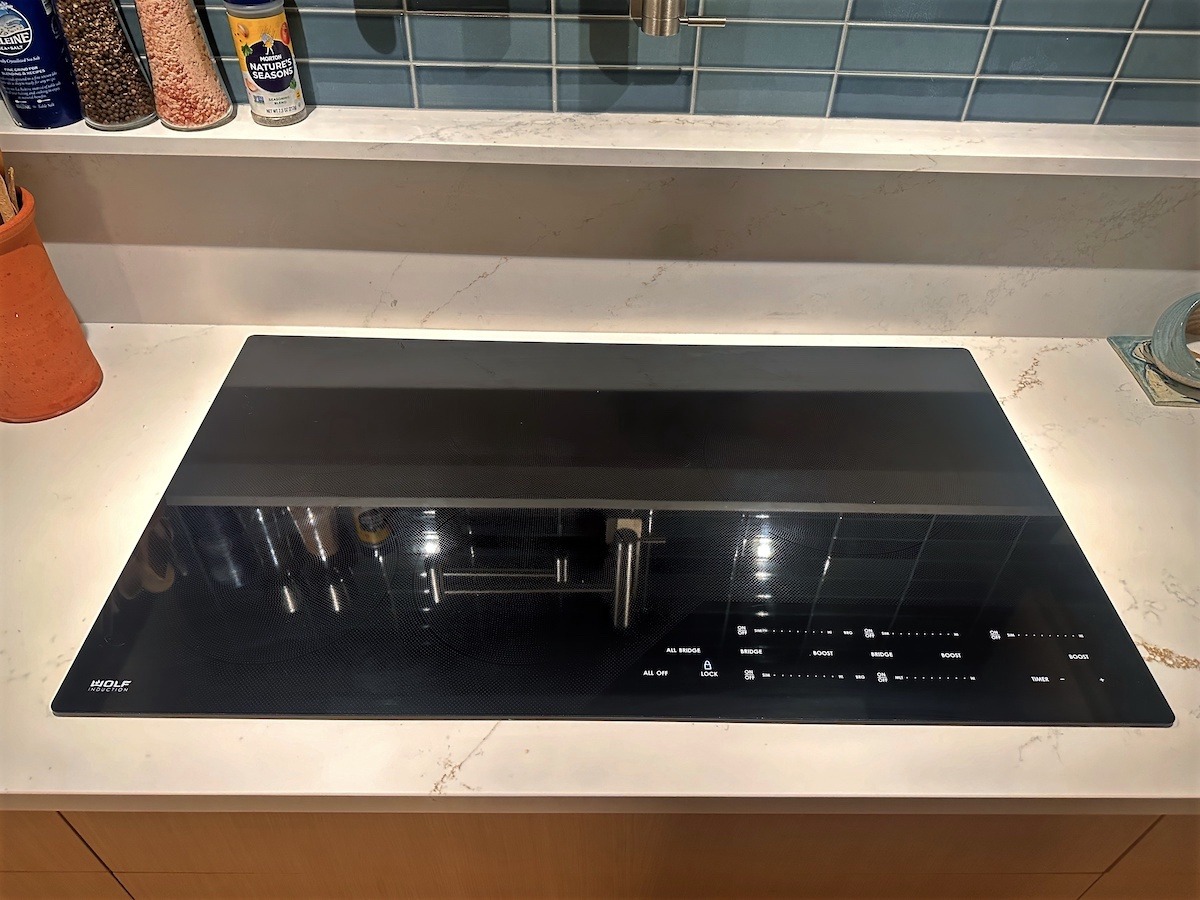

Induction Cooktop
All About Induction Cooktops
We just renovated our kitchen and decided to put in an induction stovetop rather than another gas range. The reasons included more control of cooking temperatures, easier to clean, faster water boiling at altitude, and trying something new and different.
As I learn to cook on an induction cooktop, I’ll share my experiences and the pros and cons. Below are some essential topics I considered before replacing our gas stovetop.
What is an Induction Cooktop?
Induction stovetops, or induction cooktops, are a modern and innovative technology that has revolutionized how we cook. Unlike traditional gas or electric stovetops, induction stovetops use electromagnetic fields to heat the cookware directly instead of heating the air around it. This article will discuss induction stovetops’ working principle, advantages, and disadvantages.
Working principle
Induction stovetops use electromagnetism to generate heat, which is a process that occurs when an electrical current flows through a coil of wire. The induction coil is placed underneath a glass surface, and when an electric current is passed through it, it generates a magnetic field. When a ferromagnetic (magnetic) cookware is placed on the surface, the magnetic field induces an electrical current in the cookware, generating heat.
The heat generated in the cookware is very efficient, as it is produced directly in the cookware itself and not in the air around it. This means the cookware heats up quickly without wasted heat. The heat can also be adjusted instantly, which makes it easier to control the temperature while cooking.
Who invented the induction cooktop, and what is its history?
Frigidaire invented the induction stovetop in the 1970s. However, the technology behind induction cooking can be traced back to the early 1900s when Nikola Tesla first discovered the principles of electromagnetic induction.
Tesla’s research led to the development of induction heating, first used in industrial applications such as melting and forging metals. In the 1930s, an American scientist named Albert Leroy Marsh filed the first patent for an induction cooking appliance. However, it was in the 1970s that induction stovetops became commercially available.
Frigidaire, a subsidiary of General Motors, was the first company to introduce an induction stovetop for home use in 1979. The Frigidaire induction stovetop used a single induction coil and was marketed as a faster, safer, and more energy-efficient alternative to traditional gas and electric stovetops.
Despite its many advantages, induction cooking remained a niche technology for several decades due to its high cost and limited availability. However, in recent years, manufacturing and materials technology advancements have made induction stovetops more affordable and widely available. Today, induction stovetops are increasingly popular in homes and professional kitchens worldwide, thanks to their many benefits, including speed, efficiency, safety, and precision.
Advantages
- Energy-efficient: Induction stovetops are very energy-efficient, using less energy to generate the same amount of heat as traditional stovetops. This is because the heat is generated directly in the cookware, and there is no wasted heat.
- Faster cooking: Induction stovetops heat up much faster than gas or electric stovetops, as the heat is generated directly in the cookware. This means that water boils faster, and food cooks more quickly.
- Safer: Induction stovetops are safer than gas or electric stovetops, as there is no open flame or exposed heating element. This means there is no risk of a gas leak or accidental burns from touching a hot surface.
- Easier to clean: Induction stovetops have a smooth and flat surface, making them much easier to clean than traditional stovetops. There are no grates, burners, or knobs to clean, and spills can be wiped up easily with a damp cloth.
- Precise temperature control: Induction stovetops offer precise temperature control, making cooking delicate dishes that require specific temperatures easier.
- Stylish design: Induction stovetops have a sleek and modern design, which can add a touch of elegance to any kitchen. They also come in various sizes and shapes, making it easy to find one that fits your kitchen’s style and layout.
Disadvantages
- Requires magnetic cookware: Induction stovetops only work with ferromagnetic (magnetic) cookware, which means you may need to purchase new cookware if your current cookware is incompatible.
- Initial cost: Induction stovetops are more expensive than traditional ones, so they may only be affordable for some.
- Noise: Induction stovetops can make a humming noise that annoys some people.
- Limited heat distribution: Induction stovetops only heat the part of the cookware that is in contact with the surface, which means that they may not be suitable for large cookware or dishes that require even heat distribution.

Induction Stovetop
What cooking materials work on an induction cooktop?
Induction stovetops only work with ferromagnetic (magnetic) cookware, which means that the material must contain iron or a magnetic material. The induction stovetop uses electromagnetism to generate heat and induces an electrical current in the magnetic cookware to produce heat.
Some materials that work on an induction stovetop include:
- Stainless steel cookware is one of the most popular options for induction stovetops because it contains iron and is magnetic. However, not all stainless steel cookware suits induction cooking, so checking the manufacturer’s specifications before purchasing is essential.
- Cast iron cookware is also an excellent choice for induction stovetops because it is magnetic and retains heat well. Cast iron skillets, griddles, and Dutch ovens are popular choices for induction cooking.
- Enamel-coated cast iron cookware, such as Le Creuset, is another popular option for induction stovetops. The enamel coating may reduce the magnetic properties of the cookware slightly, but it should still work well with induction stovetops.
- Carbon steel cookware is a lightweight alternative to cast iron and is also suitable for induction cooking. It is durable and heats up quickly, making it ideal for stir-frying and searing.
- Some copper and aluminum cookware may work on induction stovetops if they have a magnetic bottom or are layered with magnetic materials. However, not all copper or aluminum cookware is suitable for induction cooking, so checking the manufacturer’s specifications before purchasing is essential.
What materials don’t work with induction cooktops?
Induction stovetops only work with cookware made of magnetic materials, which means that non-magnetic materials will not work. Some common materials that don’t work with induction stovetops include:
- Aluminum is a non-magnetic material and will not work with an induction stovetop. However, some aluminum cookware may be layered with magnetic materials to make it compatible with induction cooking.
- Copper is also a non-magnetic material and will not work with induction stovetops. However, some copper cookware may be layered with magnetic materials to make it compatible with induction cooking.
- Glass cookware is incompatible with induction stovetops because it is not magnetic. In addition, glass is not a good conductor of heat, so it may not be suitable for cooking on other types of stovetops.
- Ceramic cookware is also not compatible with induction stovetops because it is not magnetic. However, some ceramic cookware may be layered with magnetic materials to make it compatible with induction cooking.
- Non-magnetic stainless steel: Some stainless steel cookware is magnetic and suitable for induction cooking, but not all stainless steel is magnetic. Non-magnetic stainless steel cookware will not work with induction stovetops.
It is important to note that while some cookware may be layered with magnetic materials to make it compatible with induction cooking, it is always best to check the manufacturer’s specifications before purchasing to ensure that the cookware will work with an induction stovetop. Using incompatible cookware with an induction stovetop can damage the stovetop and may even cause injury.
How is an induction cooktop safer for older people?
Induction stovetops can be safer for older people for several reasons:
- Reduced risk of burns: Induction stovetops only heat up the cookware, not the surrounding surface, so the stovetop stays relatively cool. This can reduce the risk of burns, as older adults may have decreased sensation in their skin or slower reflexes that make them more susceptible to accidental burns.
- Instant heat adjustment: Induction stovetops heat up quickly and can be adjusted instantly. This means that older adults can quickly reduce the heat if they notice something boiling over or need to step away from the stove for a moment.
- Automatic shut-off: Many induction stovetops have an automatic shut-off feature that turns off the heat after a certain period or if no cookware is detected on the stovetop. This can reduce the risk of leaving the stove on accidentally, which can be a serious safety hazard.
- Easy to clean: Induction stovetops are easy to clean because the surface gets less hot than other types of stovetops. This can be particularly beneficial for older adults with difficulty bending over or standing for long periods.
- No open flame: Induction stovetops do not use an open flame, which can be a safety concern for older adults with decreased mobility or balance. Additionally, the lack of an open flame can reduce the risk of fires in the kitchen.
How are they different from an electric stovetop?
Induction stovetops are different from electric stovetops in several ways:
- Heat source: Electric stovetops use heating coils or burners to generate heat, while induction stovetops use electromagnets to create a magnetic field that heats up the cookware directly. This means that induction stovetops heat up faster and more efficiently than electric stovetops.
- Energy efficiency: Induction stovetops are more energy-efficient than electric stovetops because they heat the cookware directly without heating the surrounding surface. This means less heat is wasted and more energy is used for cooking.
- Temperature control: Induction stovetops provide more precise temperature control than electric stovetops, allowing for more accurate and consistent cooking results.
- Safety: Induction stovetops are generally considered safer than electric ones because they do not generate an open flame and cool down quickly once the cookware is removed from the surface.
- Compatibility with cookware: As mentioned earlier, induction stovetops only work with cookware made of magnetic materials, while electric stovetops can work with a broader range of cookware, including non-magnetic materials like aluminum and copper.
- Noise: Induction stovetops may produce a humming or buzzing noise during operation due to electromagnetic vibrations, while electric stovetops are generally quieter.
- Maintenance: Induction stovetops are easier to clean and maintain than electric stovetops because the surface does not get as hot, and there are no heating coils or burners to clean.
Overall, induction stovetops offer faster, more efficient, and more precise cooking than electric stovetops. However, they may require special cookware and produce some noise during operation, which may be a consideration for some users.

My Induction Cooktop
How can an induction cooktop save money?
- Energy efficiency: Induction stovetops are more energy-efficient than other stovetops, such as gas or electric ones. They heat the cookware directly, without heating the surrounding surface, meaning less heat is wasted, and more energy is used for cooking. This can lead to significant energy savings over time.
- Faster cooking times: Induction stovetops heat up faster than other stovetops, which means you can cook your food more quickly. This can help to reduce your energy consumption and save you money on your energy bills.
- Precise temperature control: Induction stovetops offer more precise temperature control than other stovetops, which means you can cook your food more accurately and avoid overcooking or undercooking. This can help you save money by reducing food waste and ensuring you get the most out of your ingredients.
- Long-term durability: Induction stovetops are generally more durable than other types of stovetops, such as electric or gas stovetops. They have fewer moving parts and are less likely to break down over time, saving you money on repairs and replacement costs.
- Reduced maintenance costs: Induction stovetops are easy to clean and maintain, saving you money on cleaning supplies and maintenance costs over time.
- Tax credits: In some countries, governments offer tax credits or rebates for purchasing energy-efficient appliances, including induction stovetops. This can help you save money on your initial purchase and reduce overall costs over time.
How is it different to cook on an induction cooktop from gas?
- Heat source: Induction stovetops use electromagnets to create a magnetic field that heats the cookware directly, while gas stovetops use an open flame to heat up the cookware indirectly. This means that induction stovetops heat up faster and provide more precise temperature control than gas stovetops.
- Temperature control: Induction stovetops offer more precise temperature control than gas stovetops, allowing for more accurate and consistent cooking results. The temperature can be adjusted quickly and accurately with induction stovetops by simply adjusting the control panel. In contrast, with gas stovetops, the flame may need to be adjusted manually, which can be more difficult to control precisely.
- Efficiency: Induction stovetops are generally more energy-efficient than gas stovetops because they heat up the cookware directly without heating up the surrounding surface. This means less heat is wasted and more energy is used for cooking. In contrast, gas stovetops generate heat that can escape into the air, which means they may be less efficient and require more energy to cook the same amount of food.
- Safety: Induction stovetops are generally considered safer than gas stovetops because they do not generate an open flame. This reduces the risk of fires and gas leaks, which can be a safety hazard in some situations.
- Noise: Induction stovetops may produce a humming or buzzing noise during operation due to electromagnetic vibrations, while gas stovetops are generally quieter.
- Compatibility with cookware: Induction stovetops only work with cookware made of magnetic materials, while gas stovetops can work with a wider range of cookware, including non-magnetic materials like aluminum and copper.
- Response time: Gas stovetops have a faster response time than induction stovetops, which means they can heat up or cool down more quickly. This can be an advantage for certain types of cooking, such as stir-frying, where rapid temperature changes are necessary.
Overall, cooking on an induction stovetop differs from cooking on a gas stovetop in terms of heat source, temperature control, efficiency, safety, compatibility with cookware, noise, and response time. While each type of stovetop has its advantages and disadvantages, induction stovetops are generally considered faster, more energy-efficient, and safer than gas stovetops.
Five fun facts about induction cooktops
- Induction stovetops were first introduced in the 1950s, but it took several decades for them to become popular due to their high cost and limited availability.
- Many professional chefs use them, often in commercial kitchens, because of their speed, efficiency, and precision.
- They are considered one of the safest types of stovetops because they only heat the cookware and not the surrounding surface, reducing the risk of burns and fires.
- They can be more environmentally friendly than gas or electric stovetops because they use less energy and produce less waste heat.
- They can heat up a pan of water much faster than a gas or electric stovetop. For example, a 2.5-quart pot of water can boil in as little as 2 minutes on an induction stovetop, compared to 8-10 minutes on a gas stovetop and 5-7 minutes on an electric stovetop.
Are they cooktops or stovetops?
The terms “induction stovetop” and “induction cooktop” are often used interchangeably to refer to the same type of cooking appliance. Both terms refer to a flat surface with induction coils that heat magnetic cookware directly without using flames or heating elements. However, the term “cooktop” is more commonly used in North America, while “stovetop” is more commonly used in Europe and other parts of the world. Generally, both terms can describe the same type of appliance.
Some of My Favorite Cookware
 Print
Print






